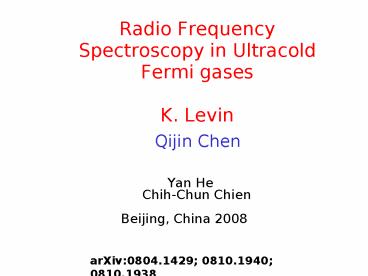Radio Frequency Spectroscopy in Ultracold Fermi gases K. Levin - PowerPoint PPT Presentation
1 / 26
Title:
Radio Frequency Spectroscopy in Ultracold Fermi gases K. Levin
Description:
High Tc superconductors have some similarity to issues being ... Provides reasonable rationale for treating cold gases and cuprates within BCS-BEC formalism ... – PowerPoint PPT presentation
Number of Views:43
Avg rating:3.0/5.0
Title: Radio Frequency Spectroscopy in Ultracold Fermi gases K. Levin
1
Radio Frequency Spectroscopy in Ultracold Fermi
gasesK. Levin
- Qijin Chen
- Yan He
- Chih-Chun Chien
- Beijing, China 2008
arXiv0804.1429 0810.1940 0810.1938
2
Some Major Messages of this Talk
- No consensus on appropriate mean field theories
of BCS-BEC crossover. Two distinct classes. - High Tc superconductors have some similarity to
issues being raised in BCS-BEC crossover. - We will see RF Spectroscopy is related to
cuprate photoemission. - RF spectroscopy is rather easily treated in
BCS-Leggett scheme at semi-quantitative level.
3
Two Major Schools of BCS-BEC Crossover which
address non-zero T1. BCS-Leggett extended to
finite T.2. Nozieres Schmitt- Rink extended
away from Tc. We prefer to use BCS-Leggett. This
is more readily applicable to cuprates
.
Important to not mix up the two schools by
computing Tc in one theory at T0 in another!
4
Strengths and Weaknesses of The Two Schools
- BCS-Leggett strength is ease and flexibility can
accommodate population imbalance, traps,
inhomogeneity. - In gap equation Treats fermions more
completely, bosons as quasi-free. - Nozieres Schmitt-Rink (as generalized by Camerino
group) leads to quantitatively better ground
state. - In gap equation Treats bosons more
completely, fermions as quasi-free. - BCS Leggett builds on fermionic mean field
theories with second order transition. NSR builds
on bosonic mean field theories with first order
transition at Tc.
5
Comparison of Generalized NSR and BCS-Leggett
Approaches
6
Self-consistent Equations Below Tc
- Gap equation BEC condition Same form as
BCS - Number Equation(s) In same form as BCS
- Pseudogap Equation Pair density (Boson number)
?2 ?pg2 ?sc2
7
Population imbalance Sarma states
gap equation
number and number difference equation
Pair fluctuations enter as
?2 ?pg2 ?sc2
pseudogap is determined as
8
Transition Temperatures Two Different Schools
Homogeneous case
Trap case
Nozieres Schmitt-Rink (red)
BCS-Leggett (black)
9
Summary of phase diagrams for Fermi gas with
population imbalance
- TOP Strict Mean field Theory. No pairing
fluctuations - BOTTOM Effects of Pairing fluctuations.
Only pairing correlations included so that phase
separation stability is over-estimated.
10
In Preparation for Cuprates Phase diagram for
Fermi gas compared with d-wave lattice
- .
D-wave lattice
S-wave gas
11
Comparison Between Cold Gases and Cuprates
- Provides reasonable rationale for treating cold
gases and cuprates within BCS-BEC formalism
12
RF SPECTROSCOPY
- .
13
Linear response theory for RF
RF current is related to response function
To lowest order , we have
Leading order spectrum depends on spectral
function A.
14
Self energy and spectral function in the
BCS-Leggett model
Condensed non-condensed pairs. This pg
contribution used in cuprate literature. Note No
Hartree terms.
When the broadening factor vanishes, we get back
to mean field theory
This is often simpler to apply.
15
Trap averaged RF spectra for un-polarized and
polarized Fermi gas
- Comparison with Innsbruck
- (unpolarized, no final state effects)
Polarization 0.5.
16
General Features of Homogeneous Spectra
Polarized and Unpolarized Case
- Note Positive and negative continua. Negative
continuum comes from pre-existing broken pairs. - In un-polarized case, there is no negative peak
in low T. It only appears when T is high enough. - In polarized case excess fermions lead to
enhanced negative continuum.
17
Comparison of photoemission-like spectra with RF
spectra (at leading order)
- Here included broadening effect. Can see effects
of approaching coherence as T decreased below Tc.
RF Spectra in homogeneous case
Photoemission
18
Theory of RF spectra with final state effects
Final state effect contribution comes from AL
diagram, the result is summarized as
Related Work by Strinati et al. T near zero, but
more quantitative calculations.
19
Final State Effects in RF and Temperature
- .
Final States on BEC side
Ground state calculations same as Basu-Mueller.
Final States on BCS side
20
How Can One Deduce Pairing Gap From RF Spectra
Within BCS-Leggett Approach?
- Ideally would like final state effects to lead to
metastable bound state in the negative continuum. - Then apply the sum rule to infer pairing gap.
21
Exploiting final State Effects (via Sum Rule) to
deduce Gap
- In this optimal situation comparison of gap and
finite interval sum rule deduced gap
22
Comparison with MIT for Tomographic scans of RF
spectra in population imbalanced trapped Fermi
gas
23
Momentum Resolved RF
- Energy distribution curves
Upward dispersing from trapped fermions at trap
edge.
Downward dispersing from broken pairs.
Above Tc
Around Tc
Below Tc
24
Contour plots of momentum resolved RF spectra for
trapped Fermi gas
- Left is experimental data from JILA, right is
theoretical results with somewhat larger
broadening factor.
25
Recent Cuprate Experiments Showing Effect of
superconducting coherence
26
Conclusions
- Two classes of theories for BCS-BEC Crossover at
finite T. Each has its strengths and weaknesses
and one should pursue both. - We illustrated some similarities with the
cuprates. - We showed that RF spectra can be calculated with
population imbalance and final state effects. The
difficulty is in using these to determine the
pairing gap. May best be done with sum rules or
with momentum resolved RF. - In future it would be exciting to address cuprate
issues - How does one describe the unusual superfluid
phase which appears in the presence of a normal
state pairing gap?































